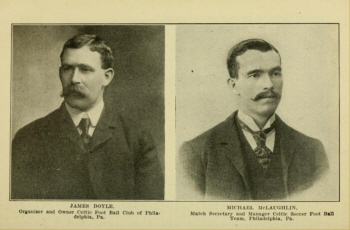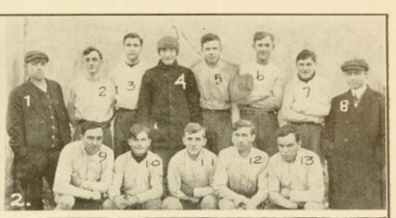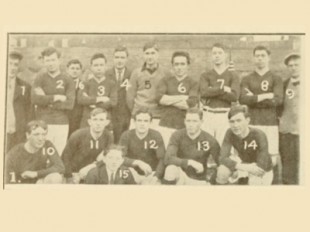Philadelphia soccer fans had five local leagues to choose from in 1911, the Cricket Club League, the Pennsylvania League, the St. George’s League, the Philadelphia and Suburban League and the Interstate League. The teams that participated in these leagues came from a range of backgrounds, from the city’s elite social clubs as was the case with the cricket clubs (the Cricket Club League, founded in 1902, remains the oldest league still operating in the United States) to ethnic social clubs, workplace-based athletic clubs, factory-sponsored semi-professional teams, neighborhood-based clubs, social welfare inspired youth organizations and school-based clubs. And that’s not counting the college teams in and around the city, whose league play took place in the fall.
Local leagues
Spurred on in some part by the visits of English touring clubs such as the Pilgrims and Corinthians, the Cricket Club League, as its name suggests, was the home of teams from the area’s cricket clubs. The membership rolls of the Philadelphia’s cricket clubs represented the elite of Philadelphia society. Whether the rosters of the cricket clubs’ soccer teams also did so is another matter. At the end of February, 1911, Moorestown was at the top of the table with 15 points (two points for a win, one for a draw) from ten matches. The Philadelphia Cricket Club was close behind with 14 points.
On the pitch, the city’s soccer elite were largely to be found in the Pennsylvania League, home to the 1910 American Cup winners Tacony FC, the team sponsored by the Disston Saw Works. At the end of February, 1911, both Tacony and Hibernian had advanced to the semifinals of the 1911 American Cup where they would face, respectively, Rhode Island’s Howard & Bullough and Connecticut’s Ansonia FC. Hibernian was at the top of the Pennsylvania League table with 19 points from 13 matches played. But, Tacony was a close second with 18 points and three games in hand. The two teams had been scheduled to meet on February 4 but the match had been postponed because of poor ground conditions. “Tacony Wallops Celtic, Score 5–2,” said the headline on February 20, the same day the league standings were published in the Philadelphia Inquirer. “Playing with remarkable combination on the muddy ground at Third and Lehigh Avenue,” Tacony was laying the groundwork for a league title push. Meanwhile, Thistle had shocked Hibernian, defeating them 3–2 at their home ground of Hibernia Park at Second and Allegheny.
The teams that competed in the St. George’s League, as the league’s name suggests, reflected the large British immigrant population within Philadelphia, which was itself often tied to the city’s large textile industry. If team names such as Robin Hood, Tennyson, Winsdor, Edward VII and Sir Robert Peel left any doubt as to the British character of the league, those doubts were answered by team names such as Albion and Anglo Saxon. At the end of February 1911, Robin Hood and Tennyson were tied with 22 points from 13 games. Robin Hood had scored 39 goals while only allowing nine. Tennyson had scored an astonishing 55 goals while letting in 22. Nipping at both team’s heels was Peabody with 21 points.
The Philadelphia and Suburban League contained a cross section of teams, with Tacony AC competing with the likes of the Irish Americans on one hand and Charlton AC on the other. Victor seemed to be running away with the league title with 25 points from 13 games, but second place Tacony AC was at 19 points with two games in hand.
In the Interstate League, workplace-based teams such as the Pennsylvania and Reading Railroad-based P & R AA and New York Shipbuilders competed against neighborhood-based teams such as Frankford and Wissahickon as well as youth organization-based teams such as Lighthouse and Boys’ Club. With 27 points from 13 games, league leaders Cardington were followed closely by P & R AA with 25 points and a game in hand.
The vibrant soccer scene in Philadelphia was underscored by the announcement of the new Allied Football competition, formed on February 17, 1911. The “lose-and-out” format would feature 24 clubs from in and around the city. At the founding meeting, “The delegates discussed the advisability of using the rubber-covered ball, but after the vote was taken it was decided to stick to the leather-covered ball in all games.”
Intercity play
Friendlies between Philadelphia clubs and clubs from other cities, as well as between Philadelphia Best XIs and visiting Best XIs, had long been a fixture on the city’s soccer calendar. An article from February 21, 1911, edition of the Philadelphia Inquirer announced a match at the Merion Cricket Club featuring a picked team composed of players from the Belmont and Merion Cricket Clubs against a team composed of players from the Crescent Athletic Club and the Staten Island Cricket and Football Club of New York. A match the year before at Haverford between a Cricket Club League best XI and one from the Field Club League of New York and New Jersey had resulted in a draw.
On February 25, a Philadelphia Best XI side composed largely of players from Thistle and Tacony, as well as players from Collingwood, Celtic and Caledonias, defeated a Newark, New Jersey Best XI side 4–3. “The local eleven gained the day by their brilliant combination among the forwards and until the final ten minutes were leading three goals to one.” That the five forwards (both teams played in a 3-2-5 formation) played so brilliantly together is remarkable given the fact that they came from four different teams. The frantic final ten minutes turned on an injury to forward T. Brown of Celtic, who had earlier scored two goals, which caused him to leave the match with a sprained ankle. “Brown’s injury was due to trying to block Mckay when the later was booting the ball,” and substitutions would not be allowed in matches for decades to come. It was the fourth time in a many years that the two such teams had met and the win meant that Philadelphia and Newark were even in the series with two wins each.
1911 American Cup
As evidenced by their strong showing in the American Cup, Philadelphia soccer teams in 1911 had a presence in the national soccer landscape through participation in the American Football Association, organizers of the American Cup competition. The AFA was founded in 1884 and was the first attempt in the United States to form a national governing body for the sport. By 1911, the Philadelphia Inquirer was reporting on the internal politics of the organization. A article from February 13 describes a contentious vote among the AFA’s executive committee at a meeting in Newark regarding a protest lodged by the True Blues of Paterson, New Jersey, over their loss to Howard & Bullough in the Quarterfinals of the American Cup. The True Blues argued that the field had been in poor shape and that the match ought to be replayed. While the article says that during the meeting, “things happened thick and fast from all accounts and more than once different delegates put on their hats and coats and began to walk out,” in the end, the True Blues lost their appeal.
They did not take the loss well. “The True Blues have a large following here, and it is said that the Blues will hold a meeting sometime in the near future for the purpose of forming a new body for the football clubs in the East.” By 1912, the American Amateur Football Association was formed. More national in scope than the AFA, the AAFA soon was named the United States Football Association and won recognition from the FIFA in 1913. Now, the organization is known as the United States Soccer Federation. Though the AFA would continue to organize the American Cup until its demise in 1925, in 1914 the USFA founded the National Challenge Cup, now known as the Lamar Hunt US Open Cup.
Back in Philadelphia, anticipation was great for a possible all-Philadelphia American Cup final between Hibernian and Tacony. Philadelphia Hibernian had defeated Jersey AC and the professional team Clan MacDonald of the New York State Football Association to reach the semifinals. Tacony had bested Wilberforce FC and Philadelphia Thistle. The match between Tacony and Thistle was itself not without controversy, with Thistle alleging that Tacony had fielded a player who was ineligible to play because he had not secured permission from the New England League, in which he had played before moving to Philadelphia, to play in the city. Thistle lost the appeal.
The February 20 article announcing of the teams’ semifinal matches on March 4 declared, “The followers of the game in this city are jubilant over the prospects of two local teams being left in the tourney, and are counting on either the Hibernians or Tacony to win the cup for this old berg.” The article noted that if both teams won their semifinal match “the American Cup authorities will likely decide to play the [final] game in this city” rather than in Newark, the home of the AFA. “If the game should be played here there is every indication that one of the largest crowds that have ever witnessed a soccer contest in this city will be on hand,” the article continued. “Let’s hope the Hibernians and Tacony win their next round,” the article concluded, “which will give the dribbling code the biggest boom it has ever had since it was first introduced in this city.”





Who won the most US Open Cups from Pennsylvania?
Bethlehem Steel (5) 1915, 1916, 1918, 1919, 1926.
Suck it Philly!
🙂